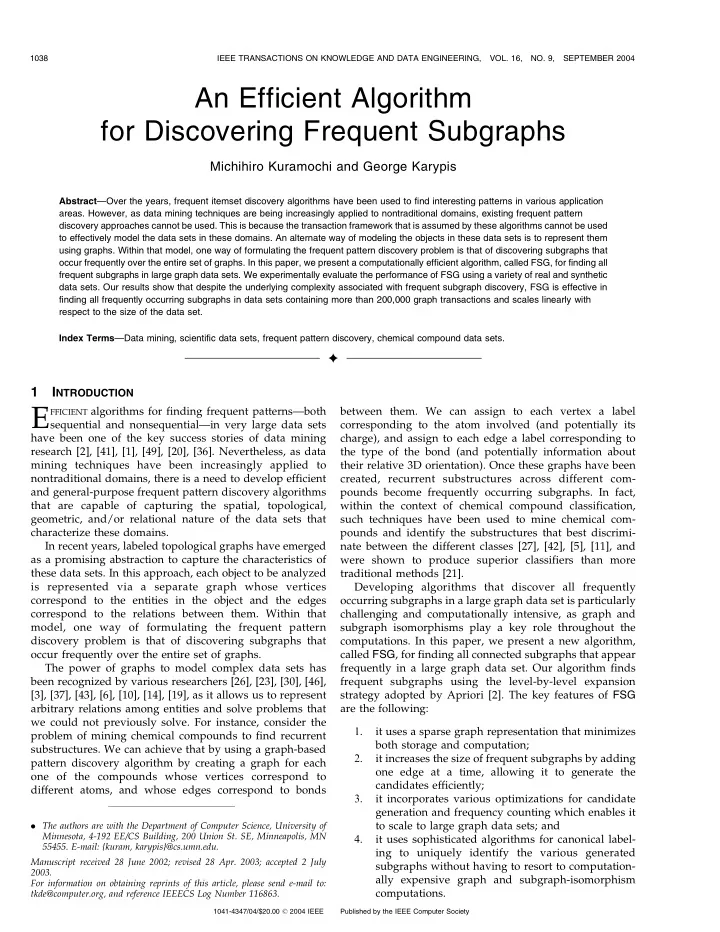

1038 IEEE TRANSACTIONS ON KNOWLEDGE AND DATA ENGINEERING, VOL. 16, NO. 9, SEPTEMBER 2004 An Efficient Algorithm for Discovering Frequent Subgraphs Michihiro Kuramochi and George Karypis Abstract —Over the years, frequent itemset discovery algorithms have been used to find interesting patterns in various application areas. However, as data mining techniques are being increasingly applied to nontraditional domains, existing frequent pattern discovery approaches cannot be used. This is because the transaction framework that is assumed by these algorithms cannot be used to effectively model the data sets in these domains. An alternate way of modeling the objects in these data sets is to represent them using graphs. Within that model, one way of formulating the frequent pattern discovery problem is that of discovering subgraphs that occur frequently over the entire set of graphs. In this paper, we present a computationally efficient algorithm, called FSG, for finding all frequent subgraphs in large graph data sets. We experimentally evaluate the performance of FSG using a variety of real and synthetic data sets. Our results show that despite the underlying complexity associated with frequent subgraph discovery, FSG is effective in finding all frequently occurring subgraphs in data sets containing more than 200,000 graph transactions and scales linearly with respect to the size of the data set. Index Terms —Data mining, scientific data sets, frequent pattern discovery, chemical compound data sets. � 1 I NTRODUCTION E FFICIENT algorithms for finding frequent patterns—both between them. We can assign to each vertex a label sequential and nonsequential—in very large data sets corresponding to the atom involved (and potentially its have been one of the key success stories of data mining charge), and assign to each edge a label corresponding to research [2], [41], [1], [49], [20], [36]. Nevertheless, as data the type of the bond (and potentially information about mining techniques have been increasingly applied to their relative 3D orientation). Once these graphs have been nontraditional domains, there is a need to develop efficient created, recurrent substructures across different com- and general-purpose frequent pattern discovery algorithms pounds become frequently occurring subgraphs. In fact, that are capable of capturing the spatial, topological, within the context of chemical compound classification, geometric, and/or relational nature of the data sets that such techniques have been used to mine chemical com- characterize these domains. pounds and identify the substructures that best discrimi- In recent years, labeled topological graphs have emerged nate between the different classes [27], [42], [5], [11], and as a promising abstraction to capture the characteristics of were shown to produce superior classifiers than more these data sets. In this approach, each object to be analyzed traditional methods [21]. is represented via a separate graph whose vertices Developing algorithms that discover all frequently correspond to the entities in the object and the edges occurring subgraphs in a large graph data set is particularly correspond to the relations between them. Within that challenging and computationally intensive, as graph and model, one way of formulating the frequent pattern subgraph isomorphisms play a key role throughout the discovery problem is that of discovering subgraphs that computations. In this paper, we present a new algorithm, called FSG , for finding all connected subgraphs that appear occur frequently over the entire set of graphs. The power of graphs to model complex data sets has frequently in a large graph data set. Our algorithm finds been recognized by various researchers [26], [23], [30], [46], frequent subgraphs using the level-by-level expansion [3], [37], [43], [6], [10], [14], [19], as it allows us to represent strategy adopted by Apriori [2]. The key features of FSG arbitrary relations among entities and solve problems that are the following: we could not previously solve. For instance, consider the it uses a sparse graph representation that minimizes 1. problem of mining chemical compounds to find recurrent both storage and computation; substructures. We can achieve that by using a graph-based it increases the size of frequent subgraphs by adding 2. pattern discovery algorithm by creating a graph for each one edge at a time, allowing it to generate the one of the compounds whose vertices correspond to candidates efficiently; different atoms, and whose edges correspond to bonds 3. it incorporates various optimizations for candidate generation and frequency counting which enables it . The authors are with the Department of Computer Science, University of to scale to large graph data sets; and Minnesota, 4-192 EE/CS Building, 200 Union St. SE, Minneapolis, MN 4. it uses sophisticated algorithms for canonical label- 55455. E-mail: {kuram, karypis}@cs.umn.edu. ing to uniquely identify the various generated Manuscript received 28 June 2002; revised 28 Apr. 2003; accepted 2 July subgraphs without having to resort to computation- 2003. ally expensive graph and subgraph-isomorphism For information on obtaining reprints of this article, please send e-mail to: computations. tkde@computer.org, and reference IEEECS Log Number 116863. 1041-4347/04/$20.00 � 2004 IEEE Published by the IEEE Computer Society
Recommend
More recommend